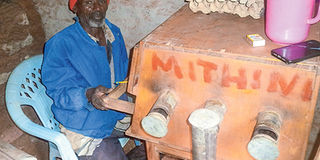Paraffin incubator hatches chicks business for 70-year-old

Joseph Kyengo, a poultry farmer in Maekani, Machakos County explains how his paraffin-powered incubator works. The machine has a capacity of 200 eggs. PHOTO | WINNIE LELEI | NMG
What you need to know:
- Mr Kyengo now maintains a flock of 20 Kienyeji hens and four cockerels where he gets his supply of fertilised eggs.
He acquired the paraffin incubator from the Agricultural Technology Development Centre (ATDC) in Katumani, Machakos County at Sh14,000, money that he paid in instalments. - The machine has a capacity of 200 eggs. Once the eggs have been arranged on their drawer, the paraffin lamp is lit and connected to the machine through an iron pipe that heats the air in the compartment by conduction, explains Mr Masila.
- Below the egg drawer is another compartment where a tin of hot water is placed. The vapour from the water is important for maintaining humidity for the hatching process to take place.
- After 21 days, the chicks begin to break out of their shells unaided. It is at this point that Mr Kyengo takes them out one by one but only after their fur has completely dried out.
Joseph Kyengo is a poultry farmer in Maekani, Machakos County, where he has been keeping chickens for the past eight years. The trade has enabled him to earn a decent income despite his advanced age of 70 years.
At the heart of his business is a simple paraffin-powered incubator, which he uses to hatch chicks. “I used to keep some 100 chickens for meat and eggs initially but I found the business costly because the birds are too demanding in terms of feeds and treatment, yet the market was not willing to pay more,” he says.
Mr Kyengo now maintains a flock of 20 Kienyeji hens and four cockerels where he gets his supply of fertilised eggs.
He acquired the paraffin incubator from the Agricultural Technology Development Centre (ATDC) in Katumani, Machakos County at Sh14,000, money that he paid in instalments. He also received training on how to use the machine for successful hatching.
"The paraffin incubator works like any other. The temperature has to be maintained at 380C and eggs turned at least three times a day for the first 14 days, then this reduces to twice a day and finally, no turning is required in the last three days,” he says.
He uses a pencil to mark the eggs so that he can track the egg-hatching process. John Masila, an agricultural engineer at ATDC, Katumani, says the ideal incubator temperature for the chicks to hatch is 380C and the humidity should be between 50 per cent and 70 per cent during the last few days.
“The turning of eggs is necessary to prevent the developing embryo from getting attached to the shell. However, this is not necessary from day 19 since the embryo is fully developed at this point,” he says.
The machine has a capacity of 200 eggs. Once the eggs have been arranged on their drawer, the paraffin lamp is lit and connected to the machine through an iron pipe that heats the air in the compartment by conduction, explains Mr Masila.
KEEP CHECKING THE MACHINE
Two other similar pipes are also connected to the machine, which act as outlets for carbon monoxide from the paraffin lamp and carbon dioxide from the embryos in the eggs.
Below the egg drawer is another compartment where a tin of hot water is placed. The vapour from the water is important for maintaining humidity for the hatching process to take place.
Mr Masila says it is necessary to keep checking the machine to ensure it works smoothly.
“The paraffin lamp has to be attended to, ensuring the soot that collects on its chimney as well as the wick are cleaned out as this affects the distribution of heat while increasing the bad gasses,” he says.
After 21 days, the chicks begin to break out of their shells unaided. It is at this point that Mr Kyengo takes them out one by one but only after their fur has completely dried out.
“If left in the egg drawer, the hatched chicks can cause harm to those that are still struggling out of their shells. They may also start moving and drop into the tin of hot water beneath the egg chamber,” he says.
From 200 eggs, Kyengo gets 180 chicks that he sells at Sh100 each when they are day-old. Two-week-old chicks sell at Sh150.
“Some clients prefer older chicks of at least a week or more because they have fewer challenges,” says Kyengo.
The farmer says he relies on his own eggs for quality. “I can source them from neighbours or traders but you cannot be guaranteed of quality. Still, you cannot know whether the eggs are fertilised or they are less than 10 days old as recommended.”




